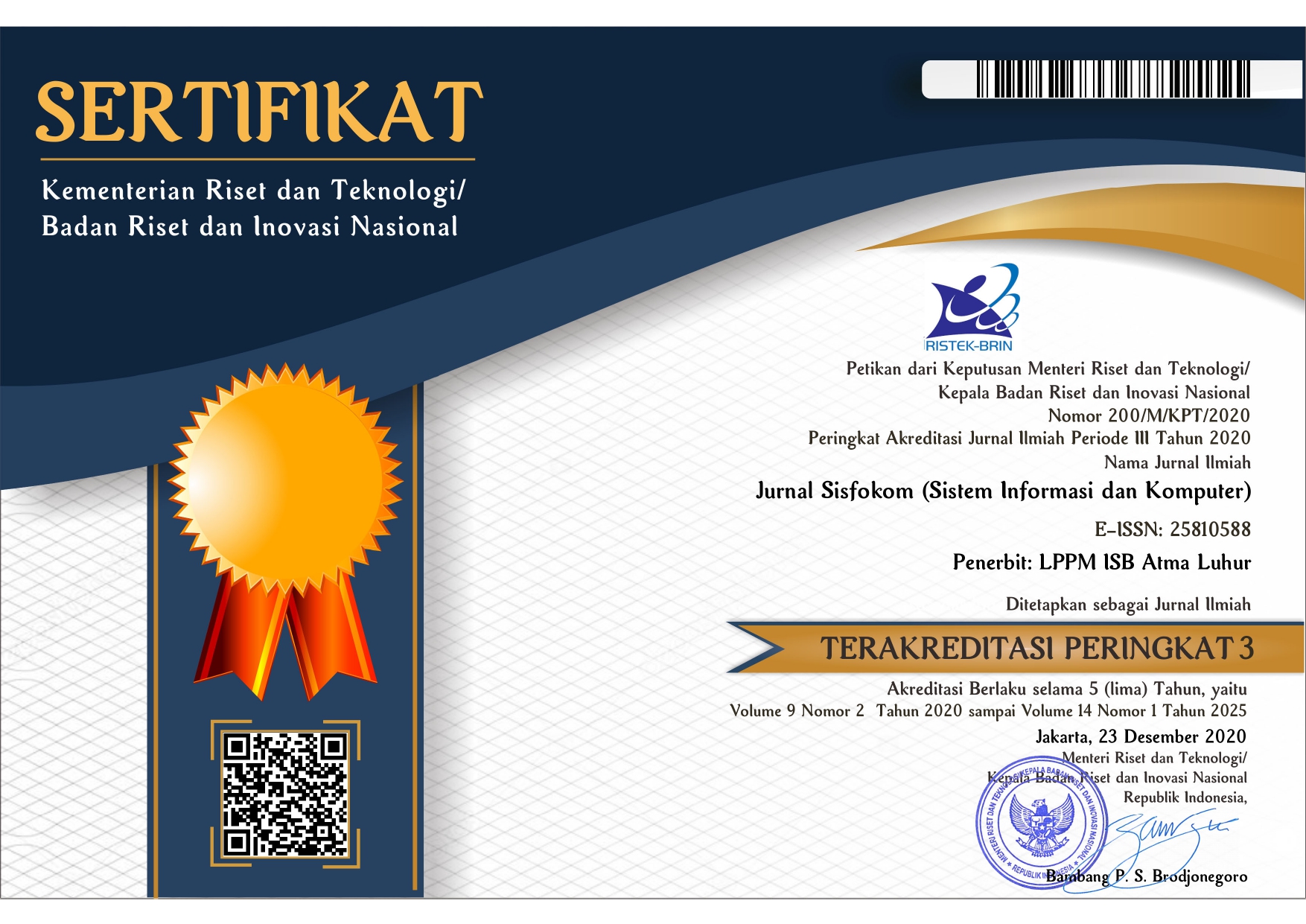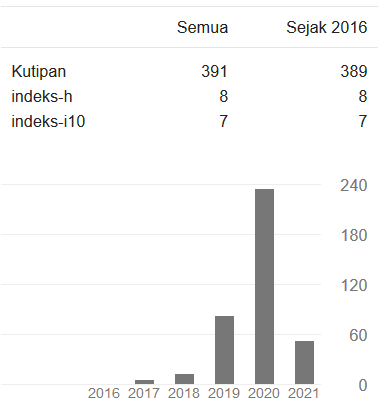Early Detection of Alzheimer's Disease with the C4.5 Algorithm Based on BPSO (Binary Particle Swarm Optimization)
DOI:
https://doi.org/10.32736/sisfokom.v12i3.1716Keywords:
Alzheimer's Disease, Dementia, Classification, Decision Tree C4.5, BPSOAbstract
Alzheimer's disease is a degenerative disease associated with memory loss, communication difficulties, mental health, thinking skills, and other psychological disorders that affect a person's daily activities. Alzheimer's disease is a disease that causes disability for people aged 70 years and over and is the seventh highest contributor to death in the world. However, until now there has not been found an effective treatment to cure Alzheimer's disease. Thus, early detection of Alzheimer's disease is very important so that sufferers of Alzheimer's disease can immediately receive intensive medical care so as to reduce the death rate from Alzheimer's disease. One method that can be used to detect Alzheimer's disease is by utilizing a machine learning algorithm model. The machine learning model in this study was carried out using the Decision Tree C4.5 algorithm classification method based on Binary Particle Swarm Optimization (BPSO). The C4.5 Decision Tree algorithm is used to classify Alzheimer's disease, while the BPSO algorithm is used to perform feature selection. By performing feature selection with the BPSO algorithm, the results show that the BPSO algorithm can improve accuracy and can increase the performance of the C4.5 algorithm in the Alzheimer's disease classification process. The results of the accuracy of the C4.5 algorithm using the BPSO feature selection are greater, namely 98.2% compared to the C4.5 algorithm without BPSO feature selection, which is only 96.4%.References
D. Kestel, “WHO Towards a dementia plan: a WHO guide. Geneva: World Health Organization,” 2021.
WHO Global action plan on the public health response to dementia 2017 - 2025. Geneva: World Health Organization. 2017. [Online]. Available: http://apps.who.int/bookorders.
S. Khotimatul Wildah, S. Agustiani, M. S. Rangga Ramadhan, W. Gata, H. Mahmud Nawawi, and S. Nusa Mandiri, “Deteksi Penyakit Alzheimer Menggunakan Algoritma Naïve Bayes dan Correlation Based Feature Selection,” JURNAL INFORMATIKA, vol. 7, no. 2, pp. 166–173, 2020, [Online]. Available: http://ejournal.bsi.ac.id/ejurnal/index.php/ji
J. S. Birks and R. J. Harvey, “Donepezil for dementia due to Alzheimer’s disease,” Cochrane Database of Systematic Reviews, vol. 2018, no. 6. John Wiley and Sons Ltd, Jun. 18, 2018. doi: 10.1002/14651858.CD001190.pub3.
A. Martin Prince et al., “World Alzheimer Report 2015 The Global Impact of Dementia An AnAlysIs of prevAlence, IncIDence, cosT AnD TrenDs.” [Online]. Available: www.alz.co.uk/worldreport2015corrections
K. Nisa Berawi, E. Cania Bustomi, M. Rokok dalam Meningkatkan Risiko Penyakit Alzheimer, and H. Mulya Budiman, “Hasril Mulya Mekanisme Rokok dalam Meningkatkan Risiko Penyakit Alzheimer.”
L. Rizzi, I. Rosset, and M. Roriz-Cruz, “Global epidemiology of dementia: Alzheimer’s and vascular types,” Biomed Res Int, vol. 2014, 2014, doi: 10.1155/2014/908915.
K. Nisa and R. Lisiswanti, “Kandita Mahran Nisa dan Rika Lisiswanti| Faktor Risiko Demensia Alzheimer MAJORITY I Volume 5 I Nomor 4 I Oktober,” 2016.
F. Akbar, “Jurnal Politeknik Caltex Riau Komparasi Algoritma Machine Learning Untuk Memprediksi Penyakit Alzheimer,” 2022. [Online]. Available: https://jurnal.pcr.ac.id/index.php/jkt/
C. Song et al., “Immunotherapy for Alzheimer’s disease: targeting β-amyloid and beyond,” Translational Neurodegeneration, vol. 11, no. 1. BioMed Central Ltd, Dec. 01, 2022. doi: 10.1186/s40035-022-00292-3.
H. Hampel et al., “Precision pharmacology for Alzheimer’s disease,” Pharmacological Research, vol. 130. Academic Press, pp. 331–365, Apr. 01, 2018. doi: 10.1016/j.phrs.2018.02.014.
M. Bari Antor et al., “A Comparative Analysis of Machine Learning Algorithms to Predict Alzheimer’s Disease,” J Healthc Eng, vol. 2021, 2021, doi: 10.1155/2021/9917919.
A. Vyas, F. Aisopos, M. E. Vidal, P. Garrard, and G. Paliouras, “Identifying the presence and severity of dementia by applying interpretable machine learning techniques on structured clinical records,” BMC Med Inform Decis Mak, vol. 22, no. 1, Dec. 2022, doi: 10.1186/s12911-022-02004-3.
Z. Abidin, E. Nurhana, Permata, and F. Ulum, “ANALISIS PERBANDINGAN ALGORITMA DECISION TREE C4.5 DAN C5.0 PADA DATA KARYAWAN BERPOTENSI PROMOSI JABATAN,” 2023. [Online]. Available: www.kaggle.com
R. A. Saputra et al., “Detecting Alzheimer’s Disease by the Decision Tree Methods Based on Particle Swarm Optimization,” in Journal of Physics: Conference Series, IOP Publishing Ltd, Nov. 2020. doi: 10.1088/1742-6596/1641/1/012025.
T. R. Sivapriya, A. R. N. B. Kamal, and P. R. J. Thangaiah, “Ensemble Merit Merge Feature Selection for Enhanced Multinomial Classification in Alzheimer’s Dementia,” Comput Math Methods Med, vol. 2015, 2015, doi: 10.1155/2015/676129.
W. Wiharto, E. Suryani, and V. Cahyawati, “The methods of duo output neural network ensemble for prediction of coronary heart disease,” Indonesian Journal of Electrical Engineering and Informatics, vol. 7, no. 1, pp. 50–57, Mar. 2019, doi: 10.11591/ijeei.v7i1.458.
J. Too, A. R. Abdullah, N. M. Saad, and W. Tee, “EMG feature selection and classification using a Pbest-guide binary particle swarm optimization,” Computation, vol. 7, no. 1, 2019, doi: 10.3390/computation7010012.
I. G. A. M. Pratama et al., “Diagnosis Penyakit Ginjal Kronis dengan Algoritma C4.5, K-Means dan BPSO,” 2022.
M. Ardiansyah, A. Sunyoto, and E. T. Luthfi, “Edumatic: Jurnal Pendidikan Informatika Analisis Perbandingan Akurasi Algoritma Naïve Bayes dan C4.5 untuk Klasifikasi Diabetes,” vol. 5, no. 2, pp. 147–156, 2021, doi: 10.29408/edumatic.v5i2.3424.
M. Qois Syafi, “Increasing Accuracy of Heart Disease Classification on C4.5 Algorithm Based on Information Gain Ratio and Particle Swarm Optimization Using Adaboost Ensemble,” Journal of Advances in Information Systems and Technology, vol. 4, no. 1, 2022, [Online]. Available: https://journal.unnes.ac.id/sju/index.php/jaist
M. Burhan Hanif and G. Guntoro Setiaji, “Meningkatkan Kinerja Decision Tree C4.5 Dengan Seleksi Fitur Korelasi Pearson Pada Deteksi Penyakit Diabetes,” Indonesian Journal of Computer Science, vol. 11, pp. 685–695, Aug. 2022.
Y. Irawan, “Penerapan Algoritma Decision Tree C4.5 Untuk Prediksi Kelayakan Calon Pendonor Darah Dengan Klasifikasi Data Mining,” vol. 2, no. 4, pp. 181–189, 2021.
D. Normawati and S. A. Prayogi, “Implementasi Naïve Bayes Classifier Dan Confusion Matrix Pada Analisis Sentimen Berbasis Teks Pada Twitter,” 2021.
F. Rofii, G. Priyandoko, M. I. Fanani, and A. Suraji, “Vehicle Counting Accuracy Improvement By Identity Sequences Detection Based on Yolov4 Deep Neural Networks,” TEKNIK, vol. 42, no. 2, pp. 169–177, Aug. 2021, doi: 10.14710/teknik.v42i2.37019.
Downloads
Published
Issue
Section
License
The copyright of the article that accepted for publication shall be assigned to Jurnal Sisfokom (Sistem Informasi dan Komputer) and LPPM ISB Atma Luhur as the publisher of the journal. Copyright includes the right to reproduce and deliver the article in all form and media, including reprints, photographs, microfilms, and any other similar reproductions, as well as translations.
Jurnal Sisfokom (Sistem Informasi dan Komputer), LPPM ISB Atma Luhur, and the Editors make every effort to ensure that no wrong or misleading data, opinions or statements be published in the journal. In any way, the contents of the articles and advertisements published in Jurnal Sisfokom (Sistem Informasi dan Komputer) are the sole and exclusive responsibility of their respective authors.
Jurnal Sisfokom (Sistem Informasi dan Komputer) has full publishing rights to the published articles. Authors are allowed to distribute articles that have been published by sharing the link or DOI of the article. Authors are allowed to use their articles for legal purposes deemed necessary without the written permission of the journal with the initial publication notification from the Jurnal Sisfokom (Sistem Informasi dan Komputer).
The Copyright Transfer Form can be downloaded [Copyright Transfer Form Jurnal Sisfokom (Sistem Informasi dan Komputer).
This agreement is to be signed by at least one of the authors who have obtained the assent of the co-author(s). After submission of this agreement signed by the corresponding author, changes of authorship or in the order of the authors listed will not be accepted. The copyright form should be signed originally, and send it to the Editorial in the form of scanned document to sisfokom@atmaluhur.ac.id.









